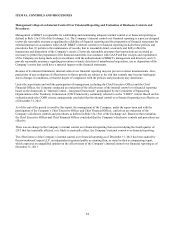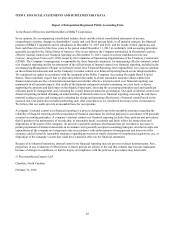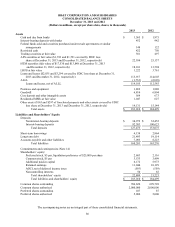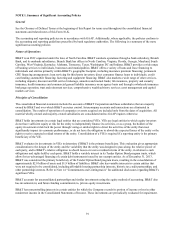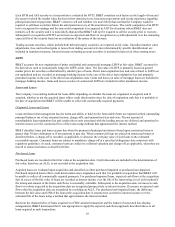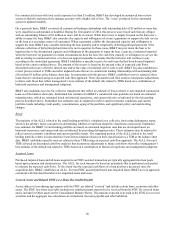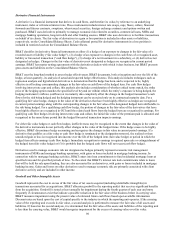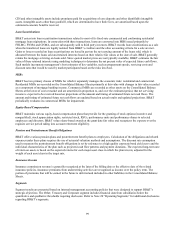BB&T 2013 Annual Report Download - page 93
Download and view the complete annual report
Please find page 93 of the 2013 BB&T annual report below. You can navigate through the pages in the report by either clicking on the pages listed below, or by using the keyword search tool below to find specific information within the annual report.
93
Each HTM and AFS security in a loss position is evaluated for OTTI. BB&T considers such factors as the length of time and
the extent to which the market value has been below amortized cost, long term expectations and recent experience regarding
principal and interest payments, BB&T’s intent to sell and whether it is more likely than not that the Company would be
required to sell those securities before the anticipated recovery of the amortized cost basis. The credit component of an OTTI
loss is recognized in earnings and the non-credit component is recognized in AOCI in situations where BB&T does not
intend to sell the security and it is more-likely-than-not that BB&T will not be required to sell the security prior to recovery.
Subsequent to recognition of OTTI, an increase in expected cash flows is recognized as a yield adjustment over the remaining
expected life of the security based on an evaluation of the nature of the increase.
Trading account securities, which include both debt and equity securities, are reported at fair value. Unrealized market value
adjustments, fees, and realized gains or losses from trading account activities (determined by specific identification) are
included in noninterest income. Interest income on trading account securities is included in interest on other earning assets.
LHFS
BB&T accounts for new originations of prime residential and commercial mortgage LHFS at fair value. BB&T accounts for
the derivatives used to economically hedge the LHFS at fair value. The fair value of LHFS is primarily based on quoted
market prices for securities collateralized by similar types of loans. Direct loan origination fees and costs related to LHFS are
not capitalized and are recorded as mortgage banking income in the case of the direct loan origination fees and primarily
personnel expense in the case of the direct loan origination costs. Gains and losses on sales of mortgage loans are included in
mortgage banking income. Gains and losses on sales of commercial LHFS are included in other noninterest income.
Loans and Leases
The Company’s accounting methods for loans differ depending on whether the loans are originated or acquired, and if
acquired, whether or not the acquired loans reflect credit deterioration since the date of origination such that it is probable at
the date of acquisition that BB&T will be unable to collect all contractually required payments.
Originated Loans and Leases
Loans and leases that management has the intent and ability to hold for the foreseeable future are reported at their outstanding
principal balances net of any unearned income, charge-offs, and unamortized fees and costs. The net amount of
nonrefundable loan origination fees and certain direct costs associated with the lending process are deferred and amortized to
interest income over the contractual lives of the loans using methods that approximate the interest method.
BB&T classifies loans and leases as past due when the payment of principal and interest based upon contractual terms is
greater than 30 days delinquent or if one payment is past due. When commercial loans are placed on nonaccrual status as
described below, a charge-off is recorded, as applicable, to decrease the carrying value of such loans to the estimated
recoverable amount. Consumer loans are subject to mandatory charge-off at a specified delinquency date consistent with
regulatory guidelines. As such, consumer loans are subject to collateral valuation and charge-off, as applicable, when they are
moved to nonaccrual status as described below.
Purchased Loans
Purchased loans are recorded at their fair value at the acquisition date. Credit discounts are included in the determination of
fair value; therefore, an ALLL is not recorded at the acquisition date.
Acquired loans are evaluated upon acquisition and classified as either purchased impaired or purchased non-impaired.
Purchased impaired loans reflect credit deterioration since origination such that it is probable at acquisition that BB&T will
be unable to collect all contractually required payments. For purchased impaired loans, expected cash flows at the acquisition
date in excess of the fair value of loans are recorded as interest income over the life of the loans using a level yield method if
the timing and amount of the future cash flows is reasonably estimable. Subsequent to the acquisition date, increases in cash
flows over those expected at the acquisition date are recognized prospectively as interest income. Decreases in expected cash
flows after the acquisition date are recognized by recording an ALLL. For purchased non-impaired loans, the difference
between the fair value and UPB of the loan at the acquisition date is amortized or accreted to interest income over the
estimated life of the loans using a method that approximates the interest method.
Based on the characteristics of loans acquired in a FDIC-assisted transaction and the impact of associated loss sharing
arrangements, BB&T determined that it was appropriate to apply the expected cash flows approach described above to all
loans acquired in such transactions.



